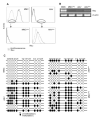HER-2/neu antigen loss and relapse of mammary carcinoma are actively induced by T cell-mediated anti-tumor immune responses
- PMID: 17304628
- PMCID: PMC3732067
- DOI: 10.1002/eji.200636639
HER-2/neu antigen loss and relapse of mammary carcinoma are actively induced by T cell-mediated anti-tumor immune responses
Abstract
Induction of tumor-specific immune responses results in the inhibition of tumor development. However, tumors recur because of the tumor immunoediting process that facilitates development of escape mechanisms in tumors. It is not known whether tumor escape is an active process whereby anti-tumor immune responses induce loss or downregulation of the target antigen in the antigen-positive clones. To address this question, we used rat neu-overexpressing mouse mammary carcinoma (MMC) and its relapsed neu antigen-negative variant (ANV). ANV emerged from MMC under pressure from neu-specific T cell responses in vivo. We then cloned residual neu antigen-negative cells from MMC and residual neu antigen-positive cells from ANV. We found marked differences between these neu-negative clones and ANV, demonstrating that the residual neu-negative clones are probably not the origin of ANV. Since initial rejection of MMC was associated with the presence of IFN-gamma-secreting T cells, we treated MMC with IFN-gamma and showed that IFN-gamma could induce downregulation of neu expression in MMC. This appears to be due to methylation of the neu promoter. Together, these data suggest that neu antigen loss is an active process that occurs in primary tumors due to the neu-targeted anti-tumor immune responses.
Figures





Similar articles
-
Signatures associated with rejection or recurrence in HER-2/neu-positive mammary tumors.Cancer Res. 2008 Apr 1;68(7):2436-46. doi: 10.1158/0008-5472.CAN-07-6822. Cancer Res. 2008. PMID: 18381452 Free PMC article.
-
Emergence of immune escape variant of mammary tumors that has distinct proteomic profile and a reduced ability to induce "danger signals".Breast Cancer Res Treat. 2006 Apr;96(3):233-41. doi: 10.1007/s10549-005-9044-4. Epub 2005 Oct 7. Breast Cancer Res Treat. 2006. PMID: 16211331
-
Danger signals and nonself entity of tumor antigen are both required for eliciting effective immune responses against HER-2/neu positive mammary carcinoma: implications for vaccine design.Cancer Immunol Immunother. 2008 Sep;57(9):1391-8. doi: 10.1007/s00262-008-0475-8. Epub 2008 Feb 16. Cancer Immunol Immunother. 2008. PMID: 18278493 Free PMC article.
-
Antitumor efficacy of CD137 ligation is maximized by the use of a CD137 single-chain Fv-expressing whole-cell tumor vaccine compared with CD137-specific monoclonal antibody infusion.Mol Cancer Ther. 2006 Jan;5(1):149-55. doi: 10.1158/1535-7163.MCT-05-0206. Mol Cancer Ther. 2006. PMID: 16432173
-
Expansion of HER2/neu-specific T cells ex vivo following immunization with a HER2/neu peptide-based vaccine.Clin Breast Cancer. 2001 Apr;2(1):73-9. doi: 10.3816/CBC.2001.n.014. Clin Breast Cancer. 2001. PMID: 11899386 Review.
Cited by
-
NOP16 promotes hepatocellular carcinoma progression and triggers EMT through the Keap1-Nrf2 signaling pathway.Technol Health Care. 2024;32(4):2463-2483. doi: 10.3233/THC-231256. Technol Health Care. 2024. PMID: 38251077 Free PMC article.
-
Polyfunctional anti-human epidermal growth factor receptor 3 (anti-HER3) antibodies induced by HER3 vaccines have multiple mechanisms of antitumor activity against therapy resistant and triple negative breast cancers.Breast Cancer Res. 2018 Aug 9;20(1):90. doi: 10.1186/s13058-018-1023-x. Breast Cancer Res. 2018. PMID: 30092835 Free PMC article.
-
Regulation of NKG2D signaling during the epithelial-to-mesenchymal transition.Oncoimmunology. 2013 Sep 1;2(9):e25820. doi: 10.4161/onci.25820. Epub 2013 Jul 29. Oncoimmunology. 2013. PMID: 24244906 Free PMC article.
-
Evolution of HER2-positive mammary carcinoma: HER2 loss reveals claudin-low traits in cancer progression.Oncogenesis. 2021 Nov 13;10(11):77. doi: 10.1038/s41389-021-00360-9. Oncogenesis. 2021. PMID: 34775465 Free PMC article.
-
Immunotherapy of cancer: targeting cancer during active disease or during dormancy?Immunotherapy. 2017 Sep;9(11):943-949. doi: 10.2217/imt-2017-0044. Immunotherapy. 2017. PMID: 29338608 Free PMC article. Review.
References
-
- Maeurer MJ, Gollin SM, Storkus WJ, Swaney W, Karbach J, Martin D, Castelli C, et al. Tumor escape from immune recognition: lethal recurrent melanoma in a patient associated with downregulation of the peptide transporter protein TAP-1 and loss of expression of the immunodominant MART-1/Melan-A antigen. J. Clin. Invest. 1996;98:1633–1641. - PMC - PubMed
-
- Yamshchikov GV, Mullins DW, Chang CC, Ogino T, Thompson L, Presley J, Galavotti H, et al. Sequential immune escape and shifting of Tcell responses in a long-term survivor of melanoma. J. Immunol. 2005;174:6863–6871. - PubMed
-
- Facoetti A, Nano R, Zelini P, Morbini P, Benericetti E, Ceroni M, Campoli M, Ferrone S. Human leukocyte antigen and antigen processing machinery component defects in astrocytic tumors. Clin. Cancer Res. 2005;11:8304–8311. - PubMed
-
- Shankaran V, Ikeda H, Bruce AT, White JM, Swanson PE, Old LJ, Schreiber RD. IFN-γ and lymphocytes prevent primary tumour development and shape tumour immunogenicity. Nature. 2001;410:1107–1111. - PubMed
Publication types
MeSH terms
Substances
Grants and funding
LinkOut - more resources
Full Text Sources
Other Literature Sources
Molecular Biology Databases
Research Materials
Miscellaneous

